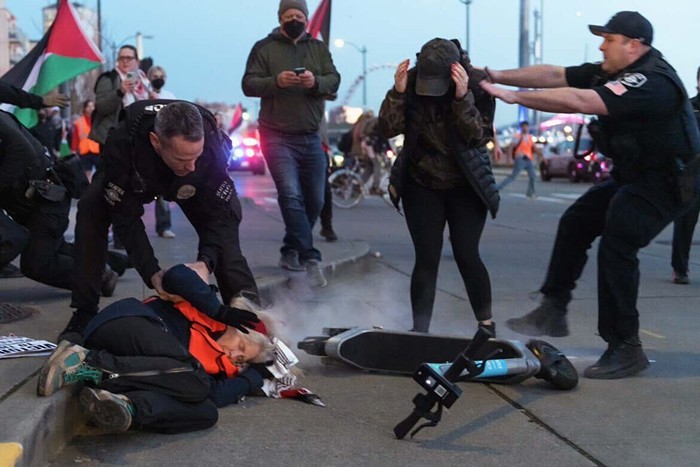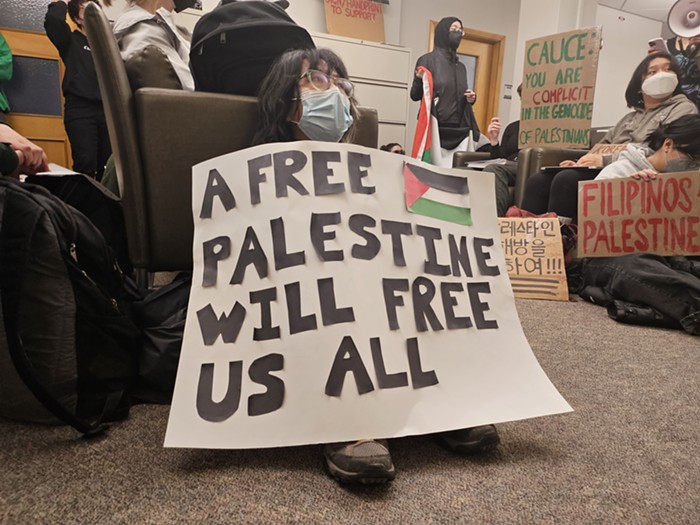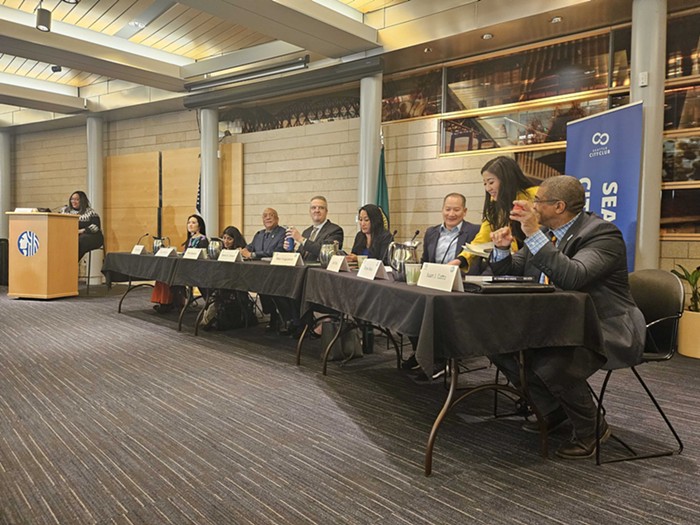During rush hour last Friday morning, Sher Kung was riding south on the notoriously-dangerous-for-cyclists Second Avenue when a box truck turned left on University Street, colliding with Kung in the intersection. The 31-year-old mother was pronounced dead, a yellow tarp laid over her body, while her damaged bicycle lay in the street and the truck's driver paced the sidewalk, distraught with grief.
Within a few hours, a quiet huddle of cyclists stood around a memorial for Kung that included a mountain of bouquets and a bicycle painted white, a so-called ghost bike. Kung had been a rising-star attorney who worked with the ACLU to lay the groundwork to overturn "don't ask, don't tell."
Her crash marked the 61st collision on Second Avenue between a vehicle and bicycle in the last four years, according to recent statistics from the city's transportation department. Half of them occurred when vehicles were turning left from Second Avenue onto cross streets.
Collisions have slowly increased in Seattle as cycling has become more popular and streets have grown more congested; there were 352 collisions in 2011 and 407 in 2012, the most recent years the city has data for, the vast majority of which resulted in injuries. Among the more high-profile crashes, a car killed Robert Townsend in the University District in 2011, and a hit-and-run SUV killed Mike Wang that same summer on Dexter Avenue North. Like Kung, the riders appeared to have the right-of-way, be traveling in bicycle lanes, and be wearing helmets.
Despite the alarming trend, the Seattle City Council has spent less than half the money required to fund our city's Bicycle Master Plan, an official commitment codified in 2007 to improve bicycle safety infrastructure.
"The council did a pretty poor job of funding the plan," says Brock Howell, the policy and government affairs manager for the Cascade Bicycle Club. "We are frustrated that there aren't more resources going toward keeping bicycle users safe."
The council renewed the plan earlier this year, which creates a fresh opportunity to make the city safer. But the council's track record is one of succumbing to anti-bicycle rhetoric about a "war on cars" and gutting money for bike safety while, conversely, allocating hundreds of millions of dollars for new freeway and street projects.
"Someone used the term 'bikelash,'" explains Council Member Mike O'Brien, who rides his bike to work, lamenting the knee-jerk reaction to pro-bike former mayor Mike McGinn. Both men were elected in 2009. "The first couple years I was in office, there was the palpable feeling at city hall and throughout the city that the city had invested too much in bike infrastructure," says O'Brien.
This latest accident was entirely preventable. Both Second and Fourth Avenues are the primary downtown thoroughfares for bicycles, but the bike lanes are counter-intuitively on the left side of the one-way streets, so vehicles turning left can hit cyclists they don't see. On September 8, the city is scheduled to complete a Second Avenue cycle track, a bike lane with physical barriers separating it from traffic, with traffic signals that show when drivers cannot turn. But that's little thanks to the council—Mayor Ed Murray had to shift city resources in May to expedite the cycle track's construction. As mayoral spokesman Jeff Reading said, September 8 is "a week too late," and that cycle track "would likely have prevented" Kung's crash.
The Second Avenue cycle track was not part of the previous version of the city's bicycle plan, yet O'Brien says the council could have done more, sooner. "Absolutely, it was physically possible to make some investments to change [Second Avenue]."
But for years, an anti-bike propaganda machine has railed against basic bike safety improvements. The Seattle Times, including its former columnist Joni Balter, has talked about cars being "shoved aside" in favor of bikes and editorialized that the city should block bike-safety money. More recently, KIRO Radio ratcheted up "war on cars" rhetoric. Host Jason Rantz became unhinged last month after the city banned right turns on Mercer Street following two bicycle collisions. His argument? "These collisions at least seem to be pretty minor," he said. Since no cyclist had been seriously injured or killed, he argued the city was hasty to take preemptive safety measures. Also on his show, Rantz said, "They make life harder for you by putting in these bike lanes that benefit a handful of people while inconveniencing the masses."
But Seattle residents disagree. A survey last year conducted by Democratic pollster FM3 and funded by the Cascade Bicycle Club found that 73 percent of Seattle voters support cycle tracks and 59 percent support giving up driving lanes to build bicycle paths.
Still, the council has quietly resisted. In 2007, the city adopted the Bicycle Master Plan with an estimated $240 million in spending required in the first decade (not accounting for inflation). But seven years later, the city's transportation department reports the council has spent only $42 million from its capital budget, less than one-quarter the funding the plan needs by now. Even accounting for a handful of tributary funds, the council funded only $11.5 million of the plan this year (the equivalent of $10 million in 2007 dollars), effectively underfunding it by roughly three-fifths.
Council Member Sally Clark, council president in 2012 and 2013, says Kung's death is a "tragedy" and that she supports eventually building a network of cycle tracks downtown.
But despite the lip service to cycling safety, she and the council have not been strong allies for cyclists. Council Member Tom Rasmussen, who chairs the council's transportation committee but did not answer questions for this article, fought bicycle improvements on Nickerson Street, saying money should be withheld until 2016. Council Member Jean Godden fought bicycle lanes in Lake City. After Townsend was killed, Council Member Clark took to her Facebook page, not to pledge more money for bicycle safety but to deride a cyclist she had seen riding in the center lane of Second Avenue—which is apparently safer than traveling in the left-hand bicycle lane, it turns out—and call the cyclist's behavior "not helpful."
Talk about not helpful.
What would be helpful?
The renewed Bicycle Master Plan calls for $390 million to $525 million over two decades. That will require $20 million a year, says Howell at the Cascade Bicycle Club, a figure the council has never come close to. The mayor will propose funding for 2015 later this month, and the council must approve it before their Thanksgiving break.
Now that another cyclist has died, will the council finally show the same resolve to pay for bicycle safety infrastructure that it's shown for freeway projects, like the stalled $4.2 billion deep-bore tunnel?
"We are hopeful," says Howell. ![]()



















